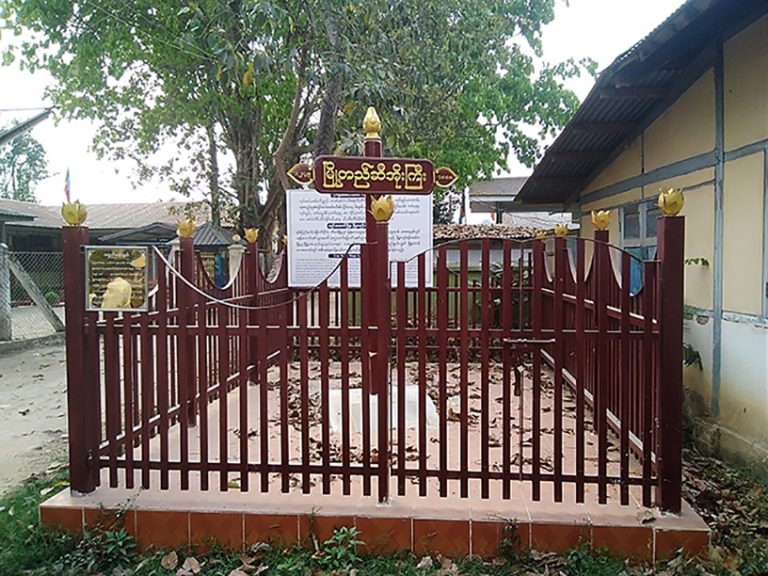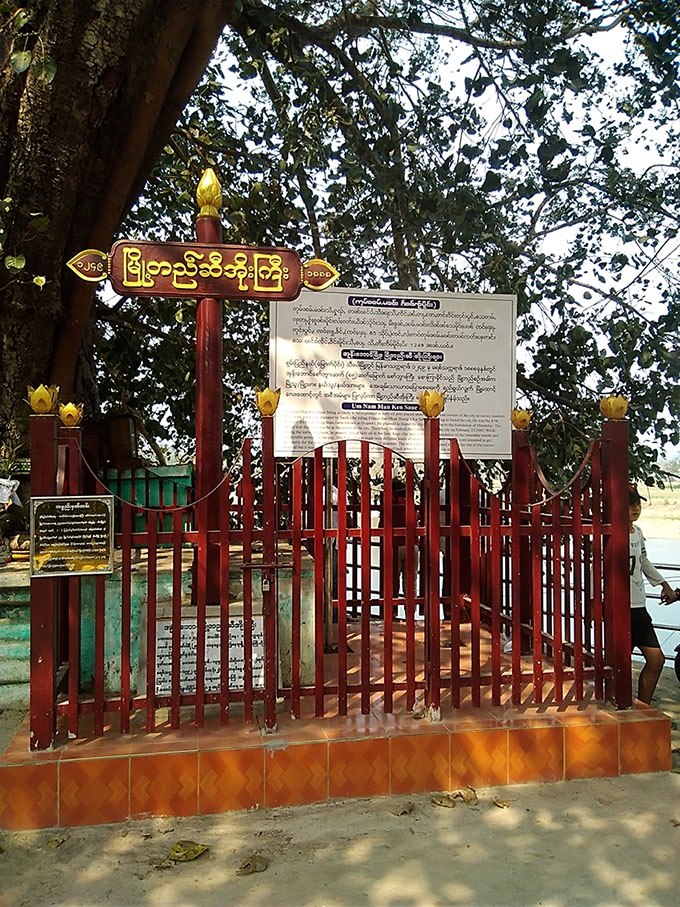2 May
King Mindon placed four holy oil pots underground at four corners of Yadanabon Mandalay in 1859 AD when the royal palace was established. About 30 years later, Ohnbaung City (now Hsipaw) in northern Shan State was established with a similar event of placing four holy oil pots at its corners.
These oil pots were excavated at the corners of Hsipaw in 1992 and then these pots were refilled with oil and placed at respective sites. The places of holy oil pots were fenced in 2019 and placed tiles there by erecting the posts. Moreover, boards bear salient points of the holy oil pots in Shan, Myanmar and English languages for observation of visitors who arrive in Hsipaw.
Thanks to journalist U Sai Tha Hlaing (Sai-Hsipaw) and retired teacher U Tun Shwe, I visited the sites of four holy oil pots in Hsipaw. Among four pots, the oil pot at the Shwenyaungbin, northeast corner of the town, takes a position on the bank of Dokhtawady River and another one, southwest of the city in paddy field outside the town.
Ancient cities in Myanmar
Among ancient cities in Myanmar, Sri Kestra and Pinle (Mongmaw) were in circular shape, Hanthawady (Bago), Ketumati (Toungoo) and Pakhangyi in rectangular shape and Kalay, Pawrithat, Wakharu and Thayetkhon (Yezin) in diamond shape.
The satellite photographs taken by U Aung Myint of the Forest Department showed ancient Inwa city was in multi-angle shape, Hanlin, Beikthanoe, Vesali and Danyawady in curved shape, MraukU in unidentified shape, Yadanabon Mandalay, Amarapura and Yadana Theinga Shwebo in square shape and Bagan in also square shape.
As population increased, renowned cities such as Tagaung, Mongmaw, Sri Kestra, Beikthanoe and Hanlin cities emerged one after another. Experts exposed ancient cities of Myanmar in successive eras through satellite images.
Hsipaw Ohnbaung
Hsipaw, one of ancient cities in Myanmar, takes a position in Kyaukme District of northern Shan State. It is 206 kilometres from Mandalay and 825 kilometres from Yangon.
The records of the Ministry of Home Affairs stated Sao Kyar Khaing (aka) Sao Hkun Seng, son of Saofa Sao Kyar Tun of Hsipaw built Hsipaw in shape of Mandalay City in March 1888. The city was established at the mouth of Nampaw Creek.
Myanmar Encyclopaedia mentioned Ohnbaung Saofa opened his office in Ohnbaung City and then moved to Hsipaw. In excavating the land for construction of the city, a piece of ruby was found.
Before the time of the government of Revolutionary Council (1962-1974 AD), a town administrator managed Hsipaw. The Ministry of Home and Religious Affairs formed Hsipaw Township with 11 wards and 476 villages of 67 village-tracts on 31 August 1972.
Hsipaw Township on 2,045 square miles of land is sharing border with Lashio and Mongyai townships in the east, Kyaukme Township in the west, Yaksawk and Kehsi townships in the south and Namhsam and Namtu townships in the north.
The township teeming with hilly areas is 1,398 feet higher than the sea level. Forests take position in the township accounting for 86.34 per cent. Dokhtawady River which crosses Hsipaw flows from the north to the south while Nampaw Creek flowing from the west to the east passes the centre of town and then joins Dokhtawady River.
According to the statistics released in September 2018, a total of 164,494 people resided in Hsipaw Township where Shan and Bamar ethnics were large population residing there together with other ethnics such as Palaung and Lisu.
The palace of Sao Ohn Kyar built in 1924 in Zatsu Ward of Hsipaw where Shan Saofas set up their palaces in the past, the Little Bagan where more than 30 pagodas in Konbaung era and Bawkyo Pagoda outside the town and Dokhtawady River are symbols of Hsipaw.
Background history of Ohnbaung
Before Hsipaw, Saofas set up palaces in Ohnbaung. The Google map shows a wall assumed that of ancient Ohnbaung City is in similar shape of a conch shell which is tip to the south.
The stone inscription of Bawkyo Pagoda mentioned King Sri Dhammasoka convened the third Buddhist synod in 235 Sasana era and built 84,000 pagodas and stupas across the world dedicating to perpetual existence of the Buddhism, including the pagoda near Dokhtawady River, west of Hsipaw and Ohnbaung city.
A partially collapsed brick wall was seen at the place assumed the edge of ancient Ohnbaung City. It was the place of Sanpheik Village, left of Hsipaw-Kyaukme road and east of Bawkyo Pagoda. According to the stone inscription, the site might be assumed as the end of ancient Ohnbaung City.
It can be assumed that ancient Ohnbaung City might have an area from the east of Bawkyo Pagoda and to the graveyard of Sir Saw Chei. Some parts of Ohnbaung City were collapsed ones and some, earthen works.
Holy oil pots of the city
Shan histories stated a total of 91 Saofas from first ever Saofa Hkun Hkam Zaw (485-520 Sasana era as well as BC 60) to last Saofa Sao Kyar Seng. But, firm evidences for the first ever Saofa were not found yet.
Sao Kyar Khaing aka Sao Hkun Seng who became the 85th Ohnbaung Saofa 143 years ago established Hsipaw in 1888 by placing four holy oil pots underground at four corners of the town with the aim of ensuring peace and prosperities of local people.
He aimed to ensure peace and prosperity of the town for a while oil from the holy pots were not dried out. These pots can store 50 viss of oil each and were placed on the three feet high brick wall.
Hsipaw was an office town for governing Hsipaw, Monglon, Mongtung and Thonze. Town plan of Hsipaw is similar to Mandalay City in shapes of residential wards on plain area and straight roads.
Saofas of Ohnbaung and Hsipaw fostered friendly relations with Myanmar kings from Hanthawady, Inwa, Amarapura and Yadanabon. Ohnbaung Saofa Sao Kyar Khaing learned royal affairs, history, religious literature, Pitakat and astrology together with sons of King Mindon such as Prince Makkhaya and Prince Thonze.
Ohnbaung Saofa Hkun Kyar Tun, the 84th Saofa, passed away on 21 October 1866. His son Sao Kyar Khaing aka Sao Hkun Seng became the 85th Saofa. He arranged establishment of a new city, south of Ohnbaung, because of dense population and shortage of water in Ohnbaung.
He coordinated with advisers and Shan ethnic leaders and assigned survey officer U Myoh to build a new city. Then, he planned to resettle residents from Ohnbaung to new city.
Construction tasks of the palace started at the site of Hsipaw People’s Hospital on 25 February 1888.
Four holy oil pots were placed underground at Shwenyaungbin, the compound of Customs Department, Okkyin Ward and Myanmaryat Lodge.
The Saofa took a sample of Mandalay for the new city because he grew up in the presence of King Mindon who established Mandalay Royal Palace with placement of four holy oil pots underground at four corners.
According to the advice of State Ovadacariya venerable Sayadaw Bhaddanta Labhavamsa from Hsipaw, holy oil pots were found in 1992.
Among the pots, a pot found in the compound of Customs Department stored oil but it was about six inches down from the brim. The pot found in the compound of Myanmaryat Lodge was full of oil. The pot in Okkyin Ward was lack of oil. But, no oil pot was found at the place from Snwenyaungbin. It was assumed that Dokhtawady River might erode the land of oil pot.
The authorities filled sesame oil in the pots at full brims and replaced them in original sites at 7 am on 12 July 1992. The place from Shwenyaungbin was kept with a new pot filled with sesame.
Four holy oil pots placed in Hsipaw more than 130 years ago distinctly remain as historical evidences for Hsipaw city.
Translated by Than Tun Aung
References:
Myanmar Encyclopaedia Volume VIII
Myanmar Dates History (Ministry of Religious Affairs and Culture)
Facts about Hsipaw Township (Ministry of Home Affairs)




